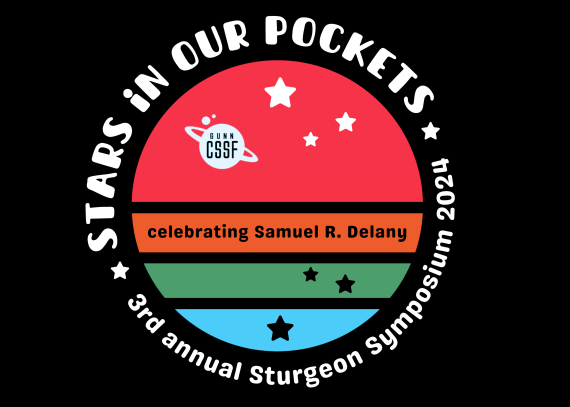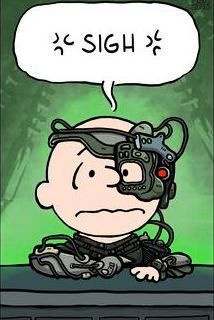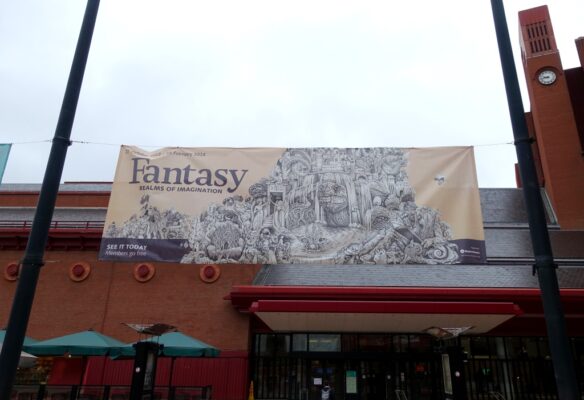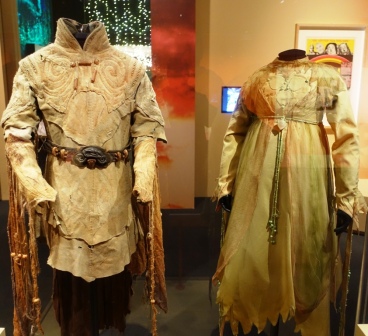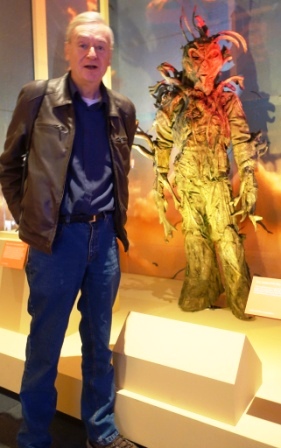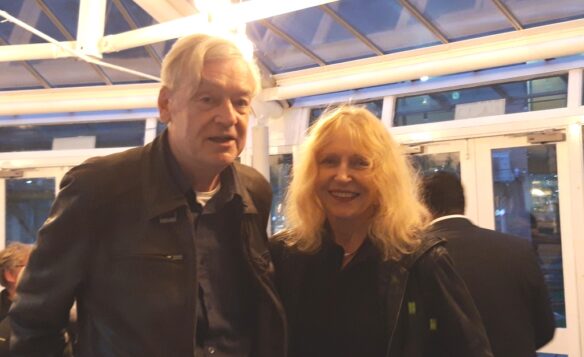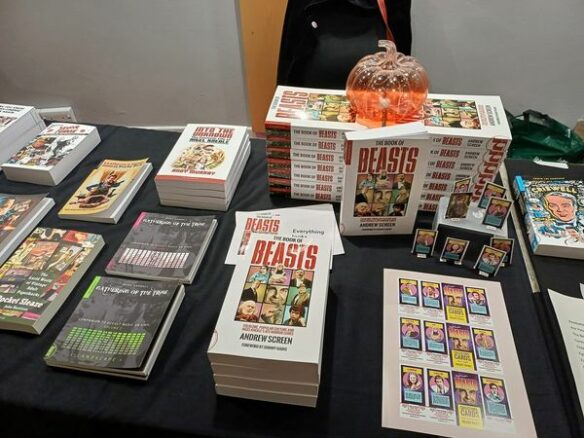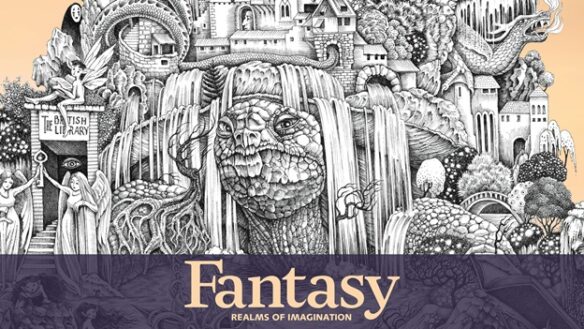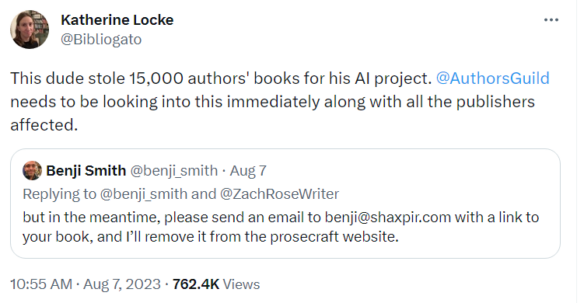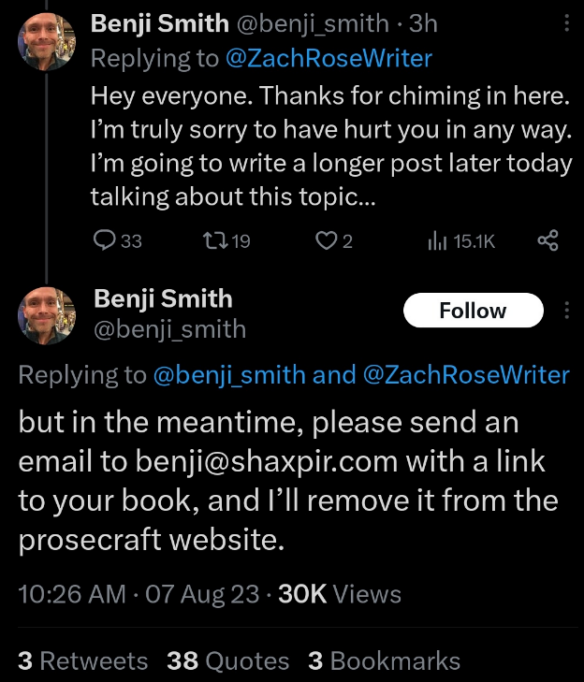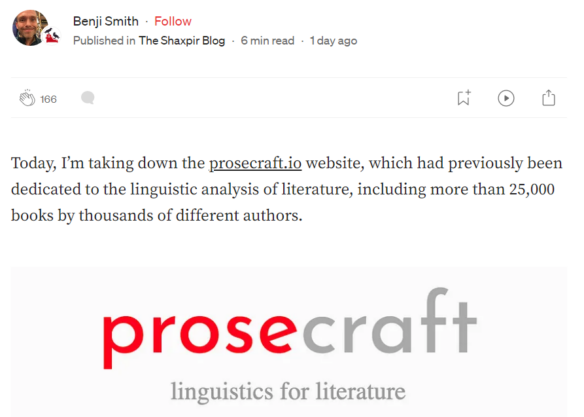(1) HELLO FROM CHINA. The Hugo Book Club Blog has a guest post from Chinese fan RiverFlow: “Guest Post: Unite Sci-Fi Fans Around The World”.
Hello science fiction fans attending the 2024 World Science Fiction Convention in Glasgow. First of all, have you heard of Chinese sci-fi fandom? If so, what examples can you give?
Science fiction fans in China were excited when Zero Gravity News won the Hugo Award for Best Fanzine last year. See “Introducing Chinese sci-fi fanzine Zero Gravity News” to learn more about the fanzine.
Yes, in fact, there is a very large group of science fiction fans in China, but few people have collected and collated their materials. I have been working on this since 2020, and have written some articles to introduce the collection.The earliest Chinese Fanzine was born in 1988. In the 1990s, many science fiction fans were employed and writing in their leisure time, but in the 21st century, these contributions were mainly completed by students. Because workers are busy with their lives and families, it is difficult to find time to organize related activities. So I wrote a book, History of Chinese University Science Fiction Association, to introduce Chinese science fiction fans to the rest of the world. The thousands of photos and hundreds of thousands of words are enough to prove the rich history of this group….

(2) LOCAL GROUP FOCUS – NORTHUMBERLAND HEATH SF. [Item by SF Concatenation’s Jonathan Cowie.] This is the Northumberland Heath SF’s group meet recently when a Mandalorian visited.
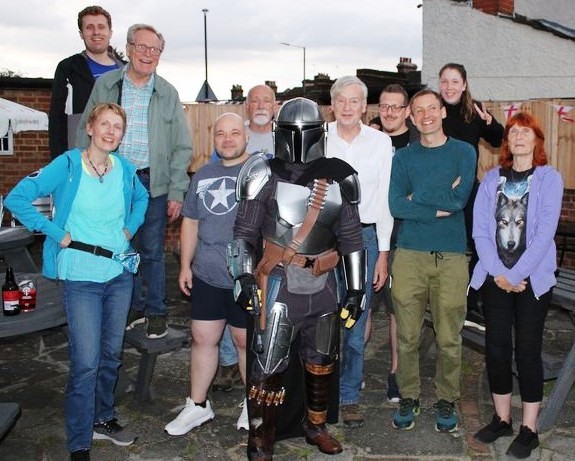
This is just half its regular membership of a score or so who turn up to at least two or three meets a year: work shift rotas, familial and other commitments, etc., mean that it is rare that all regulars attend the same meet. In addition, the group’s Facebook has some 260 followers of which half are local, but 120 of these have never physically attended a meet. (Is this typical of other local groups?) Of the non-local remainder FB followers, a good proportion are familiar names on some Worldcon registrant lists. Some of its members belong to other specialist regional and national SF groups and one of its members is the daughter of a former Worldcon fan GoH.
The group is only several years old but has some heritage connection with the former NW Kent SF group of the 1980s and ’90s that used to meet in nearby Dartford. N. Heath SF is located in southeast London, on its border in Kent, which means that in addition to local social gatherings and cinema outings, it is easy to have trips to central London events, such as the annual Sci-Fi London film fest, or one-offs, such as the Loncon 3 Worldcon. It meets the second Thursday of each month so as not to clash with the first Thursday London SF Circle (as it used to be called) gathering.
EDITOR’S NOTE: Jonathan adds, “I for one would be interested to see potted summaries of local SF groups across different countries” and I enthusiastically second the idea. I’d love to run people’s introductions to the sf groups they’re in.
(3) DOWNLOAD THE 2019 GUFF TRIP REPORT. Simon Litten’s 2019 GUFF Trip Report Visiting Nearly Kiwiland has been published. Copies can be downloaded at the Australian Fan Funds website.
There’s no charge to download the report but interested fans may wish to make a donation to GUFF (via PayPal to [email protected]).
(4) THE SELF-PUBLISHING BUSINESS. Dave Dobson offers a deep dive into the numbers in his “Anatomy of a free BookBub featured deal”. A lot to learn here about Amazon, free book campaigns, and ratings.
Also, the intangibles – the sales rank, the visibility, the (I hope) new fans, the glut of new ratings and reviews – all of those are things I’d gladly have paid a couple hundred bucks pursuing. So, I’m going to call this a clear win, and I’d do it again in a heartbeat.
(5) OCTOTHORPE. In episode 114 of Octothorpe, “Tastemaker Batty”, John Coxon, Alison Scott and Liz Batty discuss the Hugo Awards. Uncorrected transcript is available here.
We cover all the categories except Best Novel, which we covered in a previous episode. The deadline is today (20 July 2024 at 21:17 Glasgow time). Don’t forget to vote beforehand.
The value for “today” is a now-expired deadline. But that comes to us all sooner or later.

(6) PLUTO STILL NOT ONE OF THE COOL KIDS. “Astronomers Propose New Criteria to Classify Planets, but Pluto Still Doesn’t Make the Cut” in Smithsonian Magazine.
Nearly two decades after Pluto got kicked out of the planet club, astronomers are proposing an updated way to define “planet” based on more measurable criteria. The current definition is “problematic” and “vague,” they write in a paper published Wednesday in The Planetary Science Journal.
Unfortunately for fans of the dwarf planet, however, Pluto would remain excluded, even if the proposal is approved….
… “Jupiter’s orbit is crossed by comets and asteroids, as is Earth’s,” Gladman points out in a university statement. “Have those planets not cleared their orbit and thus, aren’t actually planets?”
In a bid to correct for this ambiguity, Gladman and his two colleagues propose a more measurable definition. According to their model, a celestial body is a planet if it: orbits one or more stars, brown dwarfs or stellar remnants; is more massive than 1023 kilograms (a size big enough to clear its orbit of debris); and is less massive than 2.5 x 1028 kilograms (equivalent to 13 Jupiter masses).
Pluto’s mass is 1.31 x 1022 kilograms, so it would remain excluded—but our current eight planets would retain their classification….

(7) TOP SCI-FI MOTORBIKES. SlashGear praises “10 Of The Coolest Motorcycles In All Of Science Fiction”.
…When making this list, we looked at motorcycles that specifically had a sci-fi bent to them. The 1990 Harley-Davidson Fat Boy in “Terminator 2: Judgement Day” is definitely cool, but that’s a bike that already exists. We wanted motorcycles that pushed the boundaries of transportation in the future and perhaps even inspired folks to design their own bikes that look similar in real life. These are the sci-fi motorcycles that show that while society might change in the future, riding around on a cool motorcycle never gets old. …
The list includes —
Kaneda’s bike in Akira
Kaneda’s bike in “Akira,” one of the most influential anime films of all time, isn’t just cool-looking — it inspired the famous “Akira Slide,” which has entered meme status and has been referenced in a wide range of projects, from “Batman: The Animated Series” to Jordan Peele’s “Nope.” Even when it’s not sliding, the bike is beautifully drawn.
(8) TODAY’S BIRTHDAY.
[Written by Paul Weimer.]
July 20, 1938 – Dame Diana Rigg. (Died 2020.)
By Paul Weimer:
I was introduced to Diana Rigg thanks to Roger Zelazny’s Amber.
It’ll make sense, trust me.
As you know, I am and have been an enthusiastic player of the Amber Diceless Roleplaying Game, set in the endless multiverse of the novels. Lots of players and GMs like to import ideas from other books, shows and series. (I am no exception in that regard, mind you).

One of these GMs I played with was a big enthusiast of The Steed and Peel Avengers series from the 1960’s. I was not yet familiar with the series, but after playing a session where Steed turned out to be a secret Amberite, I had to know more! Who was Steed and who was the mysterious Mrs. Peel he was looking for (as part of the plot)? (She did not actually appear on screen). The GM encouraged me to seek out The Avengers.
And thus, I discovered the original Avengers TV series, and thus, Diana Rigg. I was enchanted immediately, of course, by a beautiful kick-arse actress with skill, verve, and action. I avidly watched all the episodes of The Avengers, finding Rigg the best of the partners for McNee by a long way. The DNA of some notable action heroines with skill, verve, intelligence and independence definitely can be traced back to Rigg’s Mrs. Peel.
Later on, she was proven delightful in things such as Game of Thrones (Olenna Tyrell was a great major character for her late in her career) and, when I discovered, the weird and wonderful steampunk movie The Assassination Bureau.
But in the end, yes, for me Diana Rigg IS Mrs. Peel. Now, if only Moorcock could confirm that Peel is actually an aspect of the Eternal Champion…
(9) COMICS SECTION.
- Brewster Rockit celebrates a walk.
- F Minus is where a guy explains his relational grievance.
(10) MONSTERPIECE THEATRE. “Godzilla Takes on the Great Gatsby in Monsterpiece Theatre Comic” at The Wrap. Cover art and preview pages at the link.
Godzilla’s been on a resurgent streak, from the MonsterVerse franchise and “Godzilla Minus One” in theaters to “Monarch” on Apple TV+. Now, TheWrap can exclusively share that acclaimed writer and artist Tom Scioli is delivering comic book “Godzilla’s Monsterpiece Theatre” from IDW, with the giant lizard taking on figures from throughout literary history — including the Great Gatsby, Sherlock Holmes, H.G. Wells’ Time Traveller and a mystery man with vampiric fingers and a “D” on the back of his cape (want to take a guess?).
The three-issue series is set in 1922, with one of Jay Gatsby’s legendary parties luring the attention of the giant lizard himself. Rather than being able to woo Daisy Buchanan, he has to deal with Godzilla absolutely demolishing his estate. Gatsby follows up on the destruction by teaming with the aforementioned 20th century literary icons to take his revenge….
(11) POINT OF NO RETURN? [Item by SF Concatenation’s Jonathan Cowie.] Bad news in this week’s Science editorial: “Go/no-go for a Mars samples return”.
Last month’s return to Earth of China’s lunar lander Chang’e-6 with samples from the far side of the Moon is a reminder that there are “firsts” in robotic space exploration still to be achieved. Unfortunately, this year has seen a major set-back for the prospects of an even more extensive plan to collect samples from Mars. In April, the US National Aeronautics and Space Administration (NASA) made clear that the ballooning cost for the US Mars Sample Return mission to around $11 billion was too much and the 2040 return date was too distant. NASA has been told to look for ideas to lower costs and shorten the timeline. Shock and anger are palpable in the astronomy community.
The challenge of an exploratory robotic mission to Mars to collect samples and return them to Earth for study dates back to the post-Apollo era, 50 years ago. Twenty-five years ago, a breakthrough occurred when France and the US announced a joint Mars sample return program. Sadly, that foundered on financial grounds. Fifteen years ago, the goal of a joint project between NASA and the European Space Agency (ESA) was vetoed at a high level in NASA, possibly an echo of the previous experience.
Nonetheless, the last two US National Academy of Sciences planetary science decadal surveys gave the Mars Sample Return mission a high priority, thereby encouraging federal agencies to fund it. Then, last year, after the critical design phase and external review, the program’s price turned out to be way above expectations, leading NASA to apply brakes to the project…
The figures quoted for cost escalation of the Mars Sample Return mission are a reminder that NASA’s JWST project grew from less than $1 billion to around $10 billion. However, most of the JWST cost increases came after the design phase, the point where the Mars project is now caught. The sub[1]sequent steady growth in the cost of JWST was due to a different cause— namely, the year-by-year NASA budget negotiation in Congress. Once the design phase is completed, a large development team is formed. European collaborators watched in frustration as the annual US budget, cycle after cycle, drip-fed just enough money to sustain the JWST mission’s team but not enough to allow efficient progress. The multiyear funding of the ESA Science Programme by member states mitigates this.
NASA is now told to look for a solution to the Mars Sample Return mission, but the agency is likely caught at a tricky crossroads. A quicker, cheaper swoop to grab Mars dust and get it back to Earth could win the exploration “first,” but that will not satisfy the US National Academy decadal goals….
(12) FARM ROBOTS. [Item by Mark Roth-Whitworth.] “Could robot weedkillers replace the need for pesticides?” in the Guardian. I’m sure they will, and I expect smaller ones for gardens.
On a sweltering summer day in central Kansas, farm fields shimmer in the heat as Clint Brauer watches a team of bright yellow robots churn up and down the rows, tirelessly slicing away any weeds that stand in their way while avoiding the growing crops.
The battery-powered machines, 4ft (1.2 metres) long and 2ft (0.6 metres) wide, pick their way through the fields with precision, without any human hand to guide them….
His Greenfield agricultural technology company now builds and programs its robots in a shed behind an old farmhouse where his grandmother once lived….
…Farmers have been fighting weeds in their fields – pulling, cutting and killing them off with an array of tools – for centuries. Weeds compete with crops for soil moisture and nutrients and can block out sunlight needed for crop growth, cutting into final yields. Over the last 50-plus years, chemical eradication has been the method of choice. It is common for farmers to spray or otherwise apply several weedkilling chemicals on to their fields in a single season.
But as chemical use has expanded, so has scientific evidence that exposure to the toxic substances in weedkillers can cause disease. In addition to glyphosate’s link to cancer, the weedkilling chemical paraquat has been linked to Parkinson’s disease. Another common farm herbicide, atrazine, can be harmful to reproductive health and is linked to several other health problems.
Weedkilling chemicals have also been found to be harmful to the environment, with negative impacts on soil health and on pollinators and other important species.
… North Dakota-based Aigen Robotics has raised $19m to date. Its compact robots are powered by solar panels fixed to the top of each machine and are designed to work autonomously, sleeping and waking up on farm fields….
… Still, many farmers and academic experts are skeptical that farm robots can make a substantial difference. They say that there is simply too much farmland and too many diverse needs to be addressed by robots that are costly to make and use. The better path, many say, is for farmers to work with nature, rather than against it.
The model of regenerative agriculture – using a variety of strategies focused on improving soil health, including limiting pesticides, rotating crops, planting crops that provide ground cover to suppress weeds and avoiding disturbing the soil – is the better path, they say….
(13) ELEMENTARY. According to ScienceAlert, “Curiosity Cracked Open a Rock on Mars And Found a Huge Surprise”.
A rock on Mars has just spilled a surprising yellow treasure after Curiosity accidentally cracked through its unremarkable exterior.
When the rover rolled its 899-kilogram (1,982-pound) body over the rock, the rock broke open, revealing yellow crystals of elemental sulfur: brimstone. Although sulfates are fairly common on Mars, this is the first time sulfur has been found on the red planet in its pure elemental form….
“But do they smell like rotten eggs?” asks John King Tarpinian.
(14) SF IN 1958. [Item by SF Concatenation’s Jonathan Cowie.] Grammaticus Books has continued his deep dive into some golden age editions of SF pulps. This time he looks at a1958 edition of Fantasy & Science Fiction that saw Heinlein’s “Have Spacesuit Will Travel” which if memory serves was short-listed for a Hugo. There’s also a Richard Matheson in the mix…
(15) VIDEO OF THE DAY. [Via Cat Rambo.] “We Didn’t Start the Fire (Bardcore|Medieval/Renaissance Style Cover)” from Hildegard von Blingin’.
There are many covers of Billy Joel’s We Didn’t Start the Fire that adapt it to different times, but we wanted to give it the bardcore treatment. *Unlike the original, the list is not chronological, and jumps around in time a lot. It very loosely spans from around 400 to 1600, and is from a rather Eurocentric point of view. Thank you to my brother, Friar Funk, for devising the lyrics and providing the majority of the vocals. Many thanks as well to his new wife and our dad for joining us in the chorus at the end.
[Thanks to Chris Barkley, Cat Eldridge, SF Concatenation’s Jonathan Cowie, Mark Roth-Whitworth, Steven French, Kathy Sullivan, Teddy Harvia, Mike Kennedy, Andrew Porter, and John King Tarpinian for some of these stories. Title credit belongs to File 770 contributing editor of the day Daniel “CCR” Dern.]

